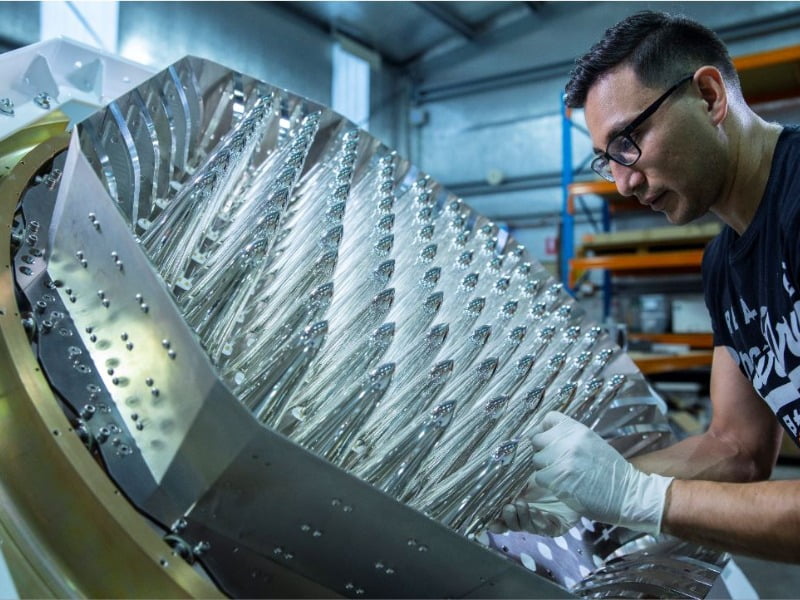The CSIRO has come together with science venture VC partners Main Sequence and a group of Australian industry partners to launch a space communications startup that traces its technology origins to WiFi and the Square Kilometre Array Pathfinder project.
The result is the launch of Quasar Satellite Technologies, a startup that CSIRO chief Larry Marshall says will allow ground stations to communicate with hundreds of satellites at once in support of a booming global space sector.
With more than 57,000 satellites expected to be launched in the next decade to underpin demand for space-derived data used in applications ranging from agriculture and environmental monitoring to defence and connecting the billions of sensors in the ‘Internet of Things’.
Present-day ground stations typically track one satellite at a time, with heavy congestion limiting the potential of satellites and the downstream industries they support.

The wholly Australian-owned Quasar Satellite Technologies aimed to use its Australian-invented and commercially developed technology to sell a global ground station “as-a-service” to the fast-growing worldwide satellite market, Dr Marshall told InnovationAus.
Quasar’s equity partners are partners include the research partner CSIRO, venture capital partner Main Sequence, and industry partners – all Australian – Vocus, Saber Astronautics, Fleet Space Technologies, and Clearbox Systems.
The company was also awarded a $1.9 million physical sciences grant from the Office of the NSW Chief Scientist & Engineer – which is not an equity partner – bringing together a total of $12 million in funding, technology and industry expertise.
Telecommunications industry veteran Phil Ridley, who has worked across some of Australia’s pioneering internet services including BigPond and Vividwireless, has been appointed as Quasar chief executive officer.
CSIRO space sector commercialisation specialist and a founding director at Quasar Dr Ilana Feain said the new company would draw on technology advances that can be traced in a direct line from the inventors of WiFI, through further development via CSIRO work on the SKA and now into a ground-breaking startup.
“The genesis of the technology was the development of the Phased Array Feed and that was developed by John O’Sullivan and his team – the inventors of WiFi – for the Australian Square Kilometre Array Pathfinder project,” Dr Feain said.
“So, it is wholly Australian-owned, and is in fact a CSIRO invention that was then a part of the SKA pathfinder project.”
CSIRO chief Dr Marshall says the Quasar startup was structured in line with the agency’s “venture science” principles, in which the CSIRO finds capital and industry expertise to bring on equity partners to take technology out of its laboratories and turn it into a commercial product.
The agency most recently did this through its V2Food plant-based meat startup that included partners Main Sequence and Competitive Foods Australia – the company behind burger giant Hungry Jacks.
Although identifying cash and in-kind inputs of $12 million, Dr Marshall says the precise value of inputs as the research partner can be tricky to measure.
“A big part of the secret sauce in these types of deals that we have been doing – these venture science deals – is that where we see something inside CSIRO or outside at a university, where we see we can bring [a piece of tech] into CSIRO labs we can spin up the TRL and de-risk it and make it a bit more investible,” Dr Marshall said.
“It’s a little difficult to say what that’s worth. It can turn into quite a lot of money, and we focus on how we can get the deal to the point where it appeals to the traditional investor from outside and who would see that as attractive.
“As you know in Australia industry is a bit risk-averse and investors are a bit risk-averse, so we have to carry them a little bit further up the TRL stack to get them over the line.
It is a Silicon Valley model, where VCs and industry outsiders work within research laboratories to identify technology that has a problem-solving commercial potential – even if Dr Marshall says Silicon Valley VC is not operating in this way to the same extent.
He says the valley “got lazy.”
“It is sort of a new model, but to be fair when I first went to Silicon Valley in 1998, for the first 25 years that I was in the valley, this is what Silicon Valley VCs actually did,” Dr Marshall said. “They came to work with Stanford and SRI and the US National Labs to try and do this.”
“And between you and me, I think they kind of got lazy. Silicon Valley became too successful, and they forgot how to make deals like this,” he said.
“In a way, Australia is sort of 20 to 30 years behind Silicon Valley, but I think we are going through that same evolution where we are realising if you really want to commercialise science, you have got to roll up your sleeves and actually go in there and do the engineering – whether you’re the investor or the founder, you’ve got to kind of work together to de-risk it.”
Do you know more? Contact James Riley via Email.


I suspect:
“Present-day satellites typically track one satellite at a time, with heavy congestion limiting the potential of satellites and the downstream industries they support.”
Should be:
‘Present-day ground stations typically track one satellite at a time, with heavy congestion limiting the potential of satellites and the downstream industries they support.’
You are so right … thanks for letting us know! I blame it on a very early start to the morning 🙂